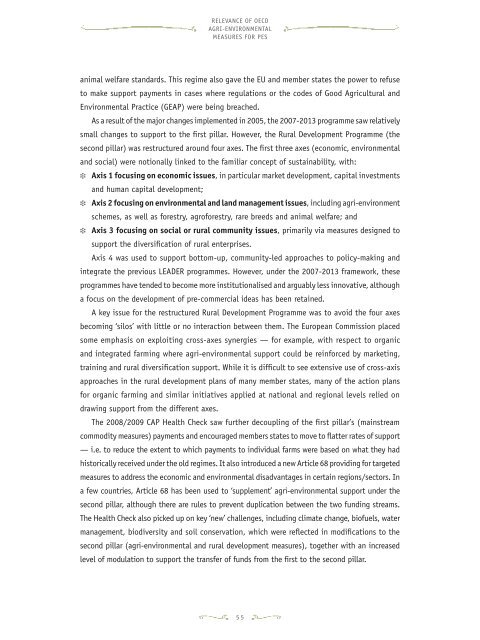agriculture and ecosystem services - Serena
agriculture and ecosystem services - Serena
agriculture and ecosystem services - Serena
Create successful ePaper yourself
Turn your PDF publications into a flip-book with our unique Google optimized e-Paper software.
Relevance of OECDagri‐environmentalmeasures for PESanimal welfare st<strong>and</strong>ards. This regime also gave the EU <strong>and</strong> member states the power to refuseto make support payments in cases where regulations or the codes of Good Agricultural <strong>and</strong>Environmental Practice (GEAP) were being breached.As a result of the major changes implemented in 2005, the 2007-2013 programme saw relativelysmall changes to support to the first pillar. However, the Rural Development Programme (thesecond pillar) was restructured around four axes. The first three axes (economic, environmental<strong>and</strong> social) were notionally linked to the familiar concept of sustainability, with:❉❉Axis 1 focusing on economic issues, in particular market development, capital investments<strong>and</strong> human capital development;❉❉Axis 2 focusing on environmental <strong>and</strong> l<strong>and</strong> management issues, including agri-environmentschemes, as well as forestry, agroforestry, rare breeds <strong>and</strong> animal welfare; <strong>and</strong>❉❉Axis 3 focusing on social or rural community issues, primarily via measures designed tosupport the diversification of rural enterprises.Axis 4 was used to support bottom-up, community-led approaches to policy-making <strong>and</strong>integrate the previous LEADER programmes. However, under the 2007-2013 framework, theseprogrammes have tended to become more institutionalised <strong>and</strong> arguably less innovative, althougha focus on the development of pre-commercial ideas has been retained.A key issue for the restructured Rural Development Programme was to avoid the four axesbecoming ‘silos’ with little or no interaction between them. The European Commission placedsome emphasis on exploiting cross-axes synergies — for example, with respect to organic<strong>and</strong> integrated farming where agri-environmental support could be reinforced by marketing,training <strong>and</strong> rural diversification support. While it is difficult to see extensive use of cross-axisapproaches in the rural development plans of many member states, many of the action plansfor organic farming <strong>and</strong> similar initiatives applied at national <strong>and</strong> regional levels relied ondrawing support from the different axes.The 2008/2009 CAP Health Check saw further decoupling of the first pillar’s (mainstreamcommodity measures) payments <strong>and</strong> encouraged members states to move to flatter rates of support— i.e. to reduce the extent to which payments to individual farms were based on what they hadhistorically received under the old regimes. It also introduced a new Article 68 providing for targetedmeasures to address the economic <strong>and</strong> environmental disadvantages in certain regions/sectors. Ina few countries, Article 68 has been used to ‘supplement’ agri-environmental support under thesecond pillar, although there are rules to prevent duplication between the two funding streams.The Health Check also picked up on key ‘new’ challenges, including climate change, biofuels, watermanagement, biodiversity <strong>and</strong> soil conservation, which were reflected in modifications to thesecond pillar (agri-environmental <strong>and</strong> rural development measures), together with an increasedlevel of modulation to support the transfer of funds from the first to the second pillar.55


